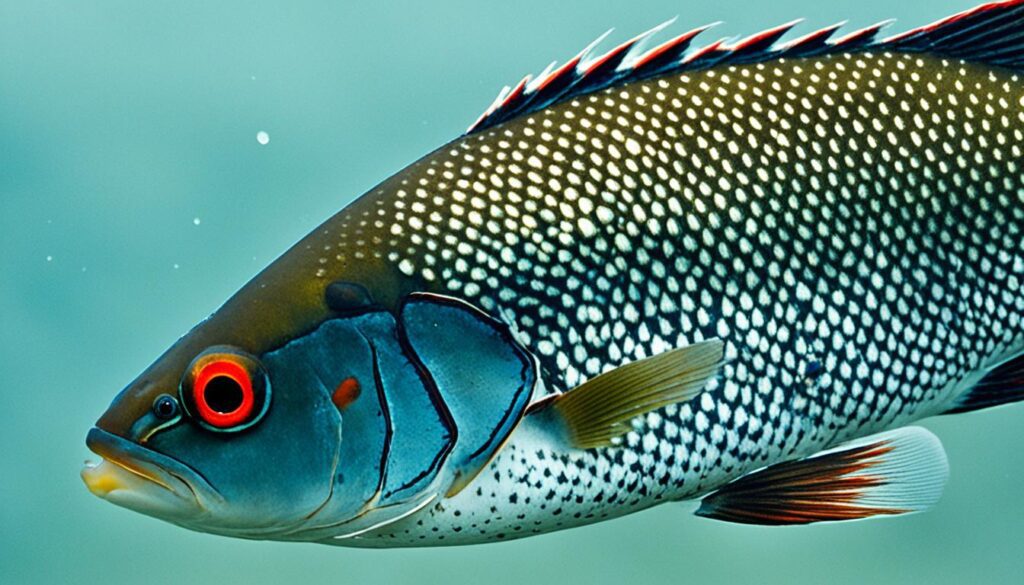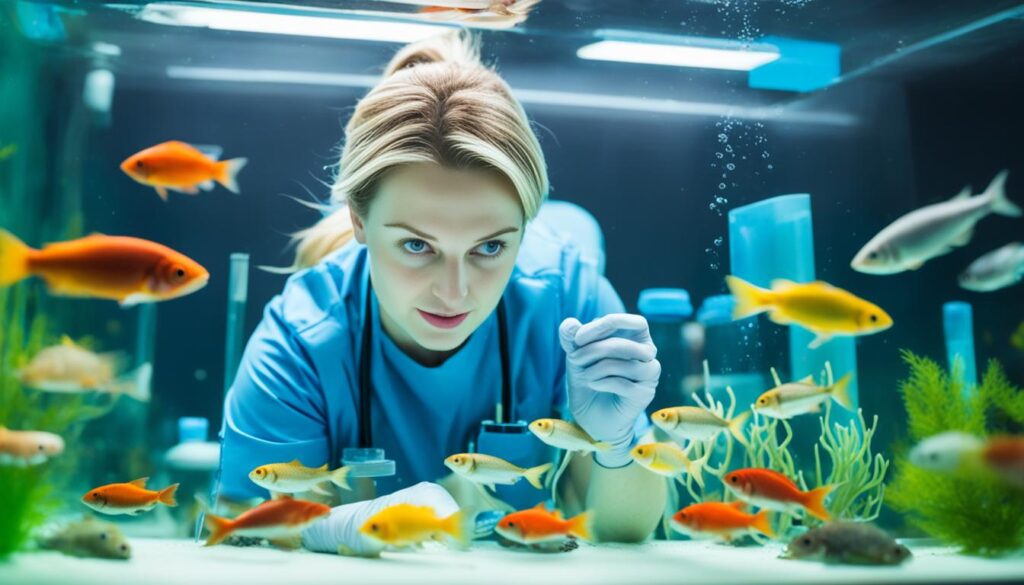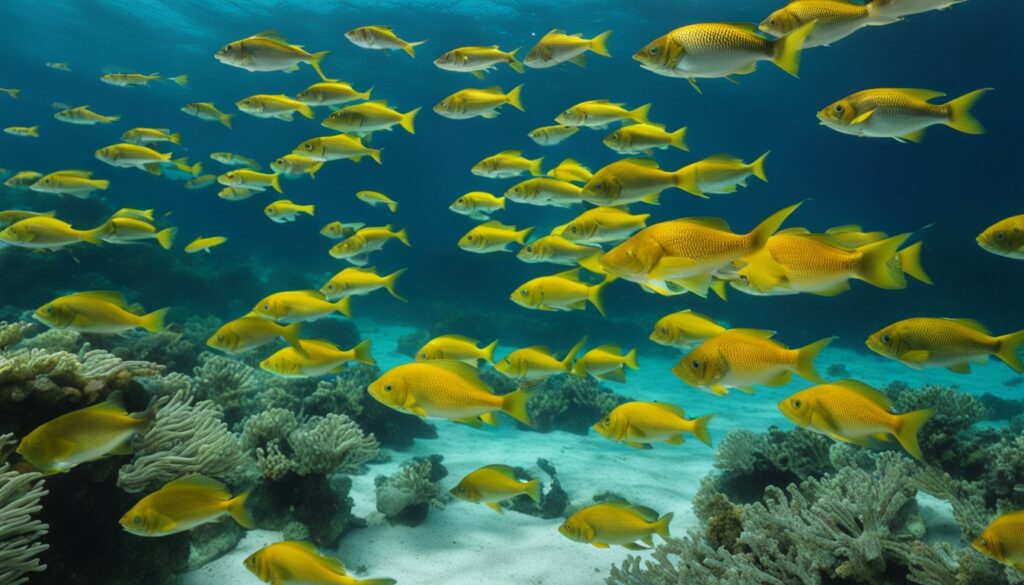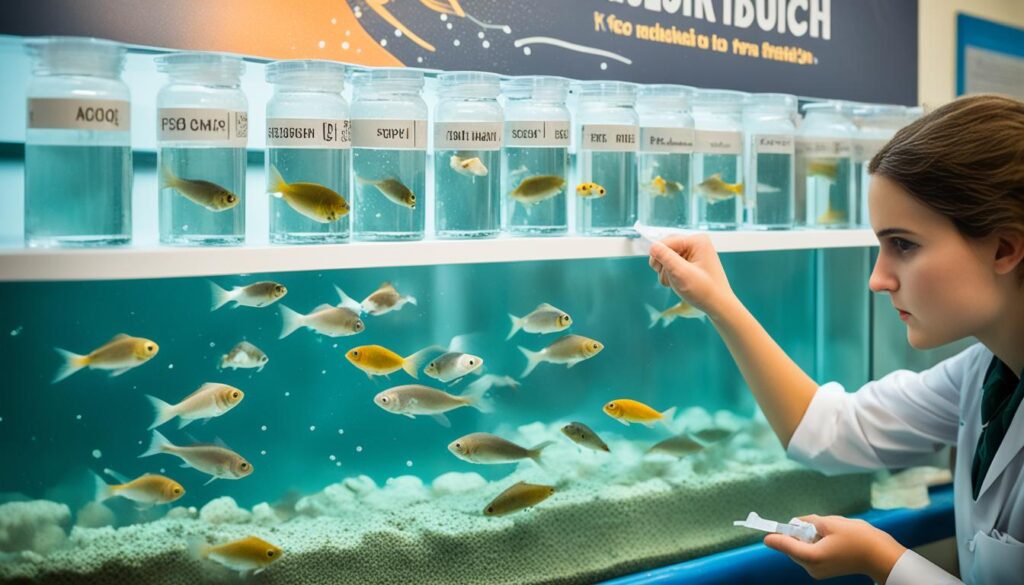Fish tuberculosis is a puzzling health issue in the world of aquatics. It’s caused by Mycobacterium spp., a tough bacteria. This infection is hard to treat and can lead to unpredictable deaths in fish.
It’s important to prevent this disease because it can spread to humans, especially through open wounds. Handling fish like catfish with care is crucial. We must protect both fish and humans from this disease with strict safety measures.
Diagnosing fish tuberculosis is tough and often requires sacrificing the fish. But, we can try to make their environment better by keeping the water clean. This might help them feel better, even if we can’t cure them.
It’s important to know that humans can get this disease too. So, we must handle tank water carefully to stop the bacteria from spreading. By taking these steps, we can keep the water safe for both fish and people.
Being aware is key. Experts like Francis-Floyd and places like Fisher Aquatic Supply Store offer great advice. They help us fight fish tuberculosis by sharing important information and tools.
We can’t cure fish tuberculosis, but we can manage it. With the right knowledge, we can keep our fish safe and our ecosystems healthy.
Understanding Fish Tuberculosis and Its Zoonotic Nature

Fish tuberculosis (TB) is a big threat to aquatic life. It can harm many species, causing losses in both wild and controlled settings. Education and fish infection control are key to fighting this disease.
Fish tuberculosis is caused by fish bacterial infections from Mycobacterium species. These bacteria can also affect humans, spreading from fish to people. Knowing how these bacteria work is crucial for preventing fish tuberculosis in high-risk areas.
What is Fish Tuberculosis?
Fish TB, or mycobacteriosis, comes from various bacteria in the Mycobacterium genus. These bacteria are tough pathogens that can live in different places. This makes fighting infection harder.
Transmission of Mycobacterium spp. Between Fish and Humans
Humans can get Mycobacterium species, like Mycobacterium marinum, from infected fish. This often happens through touching infected water or fish, especially sharp-finned ones like catfish. The bacteria can enter our bodies through cuts or wounds, triggering our immune system.
Zoonotic Risks: Handling Fish with Precaution
Handling fish can lead to diseases like fish tank granuloma. To avoid this, it’s important to wear gloves and keep clean when working with aquariums. This helps protect people who work with infected tanks and keeps the public safe.
This information shows how complex fish bacterial infections are. It highlights the need for good fish infection control to reduce risks from fish TB. By working to prevent fish tuberculosis, we can keep fish safe and protect human health. This helps both aquatic and human life thrive together.
Identifying Symptoms of Fish Tuberculosis

Fish tuberculosis (TB) is hard to spot because its symptoms are subtle and often hidden. It’s important to know these signs for good fish care. Since it can stay hidden, watching your fish closely is key.
Common Signs of Mycobacteriosis in Fish
Spotting fish TB means looking for symptoms that might seem minor at first. Infected fish may grow slowly or have belly hollows early on. Later, they might lose weight, get skin ulcers, have spinal problems, lose color, or act tired. These signs can take weeks or months to show up, making early detection hard. Watching for these signs is crucial for catching the disease early and caring for sick fish.
The Challenge of Detecting a Silent Infection
Fish TB can be tricky because some fish look fine but are sick. This silent disease can get worse without being obvious, making treatment tough. It’s different from other infections that show up fast. Being careful and watching your fish closely is very important.
Especially for home hobbyists, keeping fish healthy means watching them and keeping their tank clean. Testing the water and keeping the tank stable helps stop infections. Even though UV sterilizers don’t fight Mycobacterium spp., they help keep the tank healthy.
Since fish TB can spread to people, it’s key to be clean when handling sick fish. Wearing gloves and cleaning tools well can lower the risk of spreading the disease. This keeps the fish and people safe.
There’s no cure for fish TB, but catching it early helps with treatment. Being proactive can stop the disease from spreading in your tank and to people. If you think a fish might have TB, be careful and get advice from a vet who knows about fish diseases.
Fish Tuberculosis: Diagnostic Challenges and Techniques

Diagnosing fish tuberculosis is a tough task. It’s part of the bigger issue of fish health problems. The disease is hard to spot because Mycobacterium spp. bacteria hide well. Knowing how to diagnose and the challenges it brings is key.
One big problem is that the disease doesn’t always show clear signs. Some fish might carry it without any visible symptoms. This makes it hard to stop the disease from spreading. When symptoms do show, they can look like other, less serious issues, leading to wrong diagnoses.
When a fish dies from the disease, a quick check-up is crucial. Looking at tissue samples under a microscope is important. But, it must be done fast because tissues decay quickly. This is where new tech like PCR becomes very important:
Technique |
Usage |
Effectiveness |
|---|---|---|
PCR Testing |
Biopsy Sample Diagnosis |
Highly effective for direct detection |
Acid-fast Staining |
Confirmation of Mycobacterium |
Vital for definitive diagnosis |
Skin Tuberculin Test |
Screening for M. marinum |
67% to 100% positivity rate |
Treating fish tuberculosis is also hard. Rifampin is a strong drug against M. marinum. But, M. marinum is resistant to many antibiotics, making treatment tough.
As someone who cares about fish and their health, I know how important it is to understand fish tuberculosis. We need more research and new tests to help fish stay healthy. This will make our aquariums safer for our fish friends.
Proactive Management of Fish Health Issues

Managing fish health is key, especially with issues like fish tuberculosis and mycobacteriosis in fish. It starts with strong fish infection control and proactive health steps. Here’s how we can help a lot:
Adopting Effective Quarantine Practices
Strict quarantine is very important. Isolating new fish, plants, and other tank additions stops infectious diseases. This stops Mycobacterium spp. from spreading, which is key in controlling fish tuberculosis.
It’s vital to watch and isolate sick or dead fish right away. A pro should check them out to stop the disease from spreading. Once mycobacteriosis is found, we think all fish might have it. So, these early steps are crucial.
Strategies for Enhancing Fish Immune Systems
Keeping fish immune systems strong is crucial. Good nutrition, top-notch water quality, and low stress help fish stay healthy and fight infections better.
Nutritional support: A balanced diet with all the nutrients fish need helps them fight infections better.
Water quality: Checking and keeping the water clean supports a healthy fish home and stops bacteria that cause disease.
Stress reduction: A calm aquarium means less stress for fish, which is good for their health and fighting off diseases like fish tuberculosis.
Following these steps helps keep your fish healthy and cuts down on diseases like mycobacteriosis in fish. By being careful and proactive, we can give our fish a better life.
Action |
Benefit |
Impact on Fish Health |
|---|---|---|
Strict quarantine of new fish |
Prevents introduction of pathogens |
Reduces risk of fish tuberculosis |
Maintain high water quality |
Supports immune function |
Decreases likelihood of infections |
Nutrient-rich diet |
Enhances natural defense mechanisms |
Boosts resistance to mycobacteriosis |
Treatment Limitations and Supportive Measures for Fish tb Treatment

Fish tuberculosis (TB) is a tough condition that can’t be cured. We focus on slowing its spread by managing the disease. Since there are few treatment options, we rely on supportive care to help fish.
Understanding the Lack of Effective Treatments
There are no specific treatments for TB in fish yet. So, we focus on prevention and supportive care. Keeping the water clean and providing a good living space helps slow the disease and improves the fish’s life.
Implementing Supportive Care for Infected Fish
For fish with mycobacteriosis, we ensure clean water, balanced food, and reduce stress. Changing tank conditions and water quality can help. This includes keeping the water at the right temperature, using good filters, and changing the water often to remove harmful germs.
Here’s a look at how different fish are affected by TB:
Fish Species |
Common Environment |
Susceptibility to Mycobacteriosis |
|---|---|---|
Striped Bass |
Freshwater Systems |
High |
Sea Bass |
Mariculture |
High |
Florida Pompano |
Mariculture |
Moderate to High |
Sea Horses |
Marine Aquaria |
Extremely High |
Zebrafish |
Research Colonies |
Widespread Prevalence |
Managing these fish species requires careful tracking and prevention to stop TB from spreading. Each type of fish reacts differently to the disease, so we need specific care plans.
Preventing Fish Tuberculosis Through Biosecurity and Hygiene
As a hobbyist and advocate for fish health, I know how important it is to prevent fish tuberculosis. It’s not just about treating the disease; it’s about preventing it. By following strict biosecurity and hygiene rules, we can control fish infections. It’s important to get rid of any porous items from infected tanks. These items can’t be cleaned well and might spread the disease.
Using safe handling practices is better than old ways of fighting infections. This means wearing gloves and avoiding touching tank water if you have cuts. Studies by Beran V et al show that UV sterilizers don’t work against this bacteria in fish. So, we must focus on cleaning well and using protective gear to stop the disease from spreading.
The aquaculture industry also faces these challenges. Cabello FC et al found that more fish are becoming resistant to antibiotics because of farming practices. We must follow rules like the European Commission Directive 2006/88/EC to fight fish tuberculosis. These rules help keep fish healthy and safe for people who depend on them for food.








